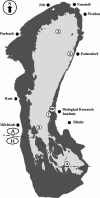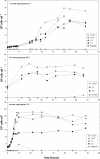Rapid growth of planktonic Vibrio cholerae non-O1/non-O139 strains in a large alkaline lake in Austria: dependence on temperature and dissolved organic carbon quality
- PMID: 18245230
- PMCID: PMC2292586
- DOI: 10.1128/AEM.01739-07
Rapid growth of planktonic Vibrio cholerae non-O1/non-O139 strains in a large alkaline lake in Austria: dependence on temperature and dissolved organic carbon quality
Abstract
Vibrio cholerae non-O1/non-O139 strains have caused several cases of ear, wound, and blood infections, including one lethal case of septicemia in Austria, during recent years. All of these cases had a history of local recreational activities in the large eastern Austrian lake Neusiedler See. Thus, a monitoring program was started to investigate the prevalence of V. cholerae strains in the lake over several years. Genetic analyses of isolated strains revealed the presence of a variety of pathogenic genes, but in no case did we detect the cholera toxin gene or the toxin-coregulated pilus gene, both of which are prerequisites for the pathogen to be able to cause cholera. In addition, experiments were performed to elucidate the preferred ecological niche of this pathogen. As size filtration experiments indicated and laboratory microcosms showed, endemic V. cholerae could rapidly grow in a free-living state in natural lake water at growth rates similar to those of the bulk natural bacterial population. Temperature and the quality of dissolved organic carbon had a highly significant influence on V. cholerae growth. Specific growth rates, growth yield, and enzyme activity decreased markedly with increasing concentrations of high-molecular-weight substances, indicating that the humic substances originating from the extensive reed belt in the lake can inhibit V. cholerae growth.
Figures






Similar articles
-
Interaction of Vibrio cholerae non-O1/non-O139 with copepods, cladocerans and competing bacteria in the large alkaline lake Neusiedler See, Austria.Microb Ecol. 2011 Apr;61(3):496-506. doi: 10.1007/s00248-010-9764-9. Epub 2010 Nov 4. Microb Ecol. 2011. PMID: 21049271 Free PMC article.
-
Distribution of genes for virulence and ecological fitness among diverse Vibrio cholerae population in a cholera endemic area: tracking the evolution of pathogenic strains.DNA Cell Biol. 2008 Jul;27(7):347-55. doi: 10.1089/dna.2008.0737. DNA Cell Biol. 2008. PMID: 18462070 Free PMC article.
-
Characterization and Genetic Variation of Vibrio cholerae Isolated from Clinical and Environmental Sources in Thailand.PLoS One. 2017 Jan 19;12(1):e0169324. doi: 10.1371/journal.pone.0169324. eCollection 2017. PLoS One. 2017. PMID: 28103259 Free PMC article.
-
Epidemiology & molecular biology of Vibrio cholerae O139 Bengal.Indian J Med Res. 1996 Jul;104:14-27. Indian J Med Res. 1996. PMID: 8783504 Review.
-
Inland cholera in freshwater environs of north India.Vaccine. 2020 Feb 29;38 Suppl 1:A63-A72. doi: 10.1016/j.vaccine.2019.06.038. Epub 2019 Jul 3. Vaccine. 2020. PMID: 31279566 Review.
Cited by
-
Interaction of Vibrio cholerae non-O1/non-O139 with copepods, cladocerans and competing bacteria in the large alkaline lake Neusiedler See, Austria.Microb Ecol. 2011 Apr;61(3):496-506. doi: 10.1007/s00248-010-9764-9. Epub 2010 Nov 4. Microb Ecol. 2011. PMID: 21049271 Free PMC article.
-
Spatiotemporal Dynamics of Vibrio cholerae in Turbid Alkaline Lakes as Determined by Quantitative PCR.Appl Environ Microbiol. 2018 May 17;84(11):e00317-18. doi: 10.1128/AEM.00317-18. Print 2018 Jun 1. Appl Environ Microbiol. 2018. PMID: 29625977 Free PMC article.
-
Pandemics, pathogenicity and changing molecular epidemiology of cholera in the era of global warming.Ann Clin Microbiol Antimicrob. 2017 Mar 7;16(1):10. doi: 10.1186/s12941-017-0185-1. Ann Clin Microbiol Antimicrob. 2017. PMID: 28270154 Free PMC article. Review.
-
Rapid and sensitive quantification of Vibrio cholerae and Vibrio mimicus cells in water samples by use of catalyzed reporter deposition fluorescence in situ hybridization combined with solid-phase cytometry.Appl Environ Microbiol. 2012 Oct;78(20):7369-75. doi: 10.1128/AEM.02190-12. Epub 2012 Aug 10. Appl Environ Microbiol. 2012. PMID: 22885749 Free PMC article.
-
Ocean warming and spread of pathogenic vibrios in the aquatic environment.Microb Ecol. 2013 May;65(4):817-25. doi: 10.1007/s00248-012-0163-2. Epub 2013 Jan 3. Microb Ecol. 2013. PMID: 23280498 Review.
References
-
- Abd, H., A. Weintraub, and G. Sandström. 2005. Intracellular survival and replication of Vibrio cholerae O139 in aquatic free-living amoebae. Environ. Microbiol. 7:1003-1008. - PubMed
-
- Aiken, G. R. 1985. Isolation and concentration techniques for aquatic humic substances, p 363-383. In G. R. Aiken, D. M. McKnight, and R. L. Wershaw (ed.), Humic substances in soil, sediment, and water. Geochemistry, isolation, and characterization. John Wiley and Sons, New York, NY.
-
- Blake, P. A., D. T. Allegra, and J. D. Snyder. 1980. Cholera—a possible endemic focus in the United States. N. Engl. J. Med. 302:305-309. - PubMed
-
- Boavida, M. J., and R. G. Wetzel. 1998. Inhibition of phosphatase activity by dissolved humic substances and hydrolytic reactivation by natural ultraviolet light. Freshwater Biol. 40:285-293.
-
- Broza, M., and M. Halpern. 2001. Chironomid egg masses and Vibrio cholerae. Nature 412:40. - PubMed
Publication types
MeSH terms
Substances
LinkOut - more resources
Full Text Sources
Molecular Biology Databases
Research Materials

